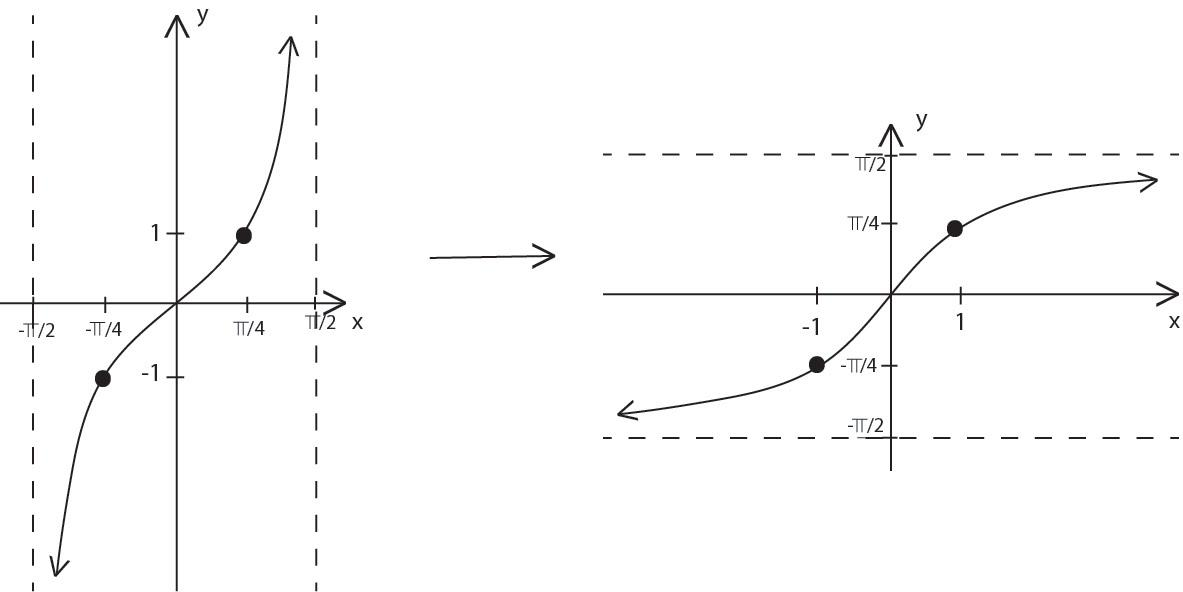
Find the domain and range of $ tan ^{-1} x$ by plotting the graph.
Answer
576k+ views
Hint: In the simplest form domain is all the values that go into the function and range is all the functions that come out of it.
Complete step-by-step answer:
Let us define the domain and range of
y =tan x
The domain of the function y =tan x is
$x \in (-\dfrac{\pi}{2},\dfrac{\pi}{2})$
The range of the function y =tan x is
$ y \in (-\infty , +\infty )$
The function $ y= tan ^{-1} x$ is symmetric to the function y=tan x with respect the line y=x
Therefore, the domain is $ x \in (-\infty , +\infty )$
and the range is $y \in (-\dfrac{\pi}{2},\dfrac{\pi}{2})$
Now we can draw the graph of the function from the observation and discuss it.

This the graph for the $y= tan ^{-1} x$ function.
Since the inverse function is obtained by reflecting the graph about the line y=x ,
The vertical asymptotes of the tangent function become horizontal asymptotes of the inverse tangent function.
As $\theta$ approaches $\infty , tan ^{-1} \theta$ approaches $-\dfrac{\pi}{2} \,as\, \theta \Rightarrow \theta , tan ^{-1} \theta \Rightarrow \dfrac{\pi}{2}$
And by reflecting the function we get the graph of the function.
Note: In the first step students need to take this assumption y= tan x otherwise they would not be able to solve the problem. Also the students need to clearly understand the meaning of domain and range of a function to solve the problem.
Complete step-by-step answer:
Let us define the domain and range of
y =tan x
The domain of the function y =tan x is
$x \in (-\dfrac{\pi}{2},\dfrac{\pi}{2})$
The range of the function y =tan x is
$ y \in (-\infty , +\infty )$
The function $ y= tan ^{-1} x$ is symmetric to the function y=tan x with respect the line y=x
Therefore, the domain is $ x \in (-\infty , +\infty )$
and the range is $y \in (-\dfrac{\pi}{2},\dfrac{\pi}{2})$
Now we can draw the graph of the function from the observation and discuss it.

This the graph for the $y= tan ^{-1} x$ function.
Since the inverse function is obtained by reflecting the graph about the line y=x ,
The vertical asymptotes of the tangent function become horizontal asymptotes of the inverse tangent function.
As $\theta$ approaches $\infty , tan ^{-1} \theta$ approaches $-\dfrac{\pi}{2} \,as\, \theta \Rightarrow \theta , tan ^{-1} \theta \Rightarrow \dfrac{\pi}{2}$
And by reflecting the function we get the graph of the function.
Note: In the first step students need to take this assumption y= tan x otherwise they would not be able to solve the problem. Also the students need to clearly understand the meaning of domain and range of a function to solve the problem.
Recently Updated Pages
Master Class 9 General Knowledge: Engaging Questions & Answers for Success

Master Class 9 English: Engaging Questions & Answers for Success

Master Class 9 Science: Engaging Questions & Answers for Success

Class 9 Question and Answer - Your Ultimate Solutions Guide

Master Class 12 Business Studies: Engaging Questions & Answers for Success

Master Class 12 Economics: Engaging Questions & Answers for Success

Trending doubts
What is meant by exothermic and endothermic reactions class 11 chemistry CBSE

Which animal has three hearts class 11 biology CBSE

10 examples of friction in our daily life

One Metric ton is equal to kg A 10000 B 1000 C 100 class 11 physics CBSE

1 Quintal is equal to a 110 kg b 10 kg c 100kg d 1000 class 11 physics CBSE

Difference Between Prokaryotic Cells and Eukaryotic Cells




